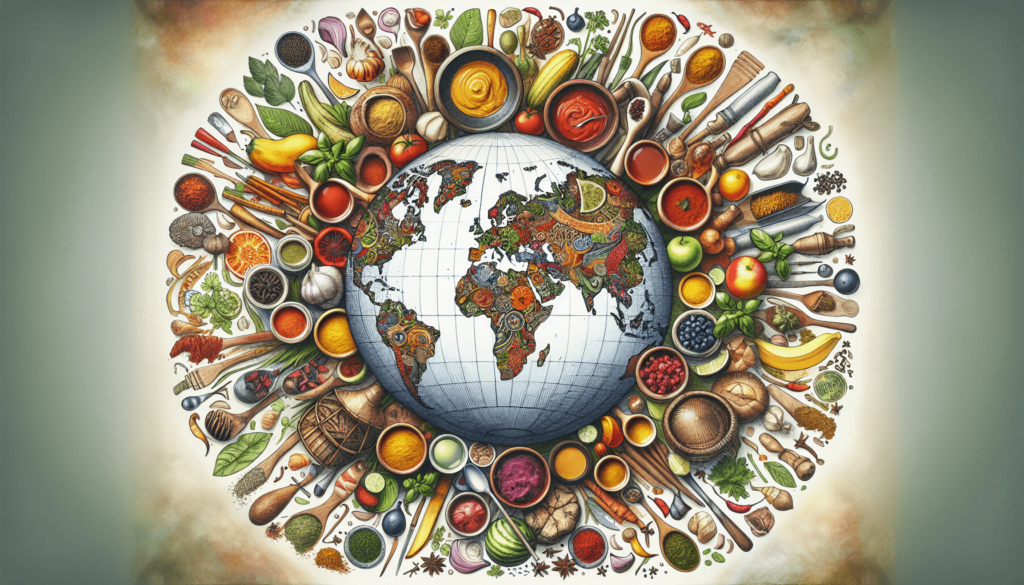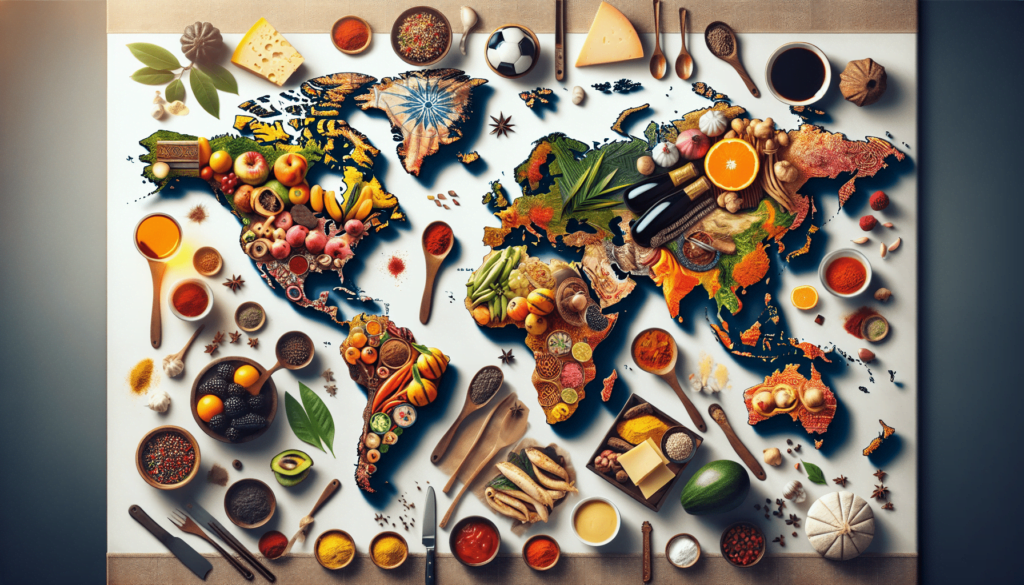Have you ever wondered how a simple meal can transport you to different corners of the world? The power of food is astonishing — it transcends borders, connects cultures, and tells stories passed down through generations. In “Exploring the World’s culinary delights: Flavorful Journeys,” you’ll uncover the rich tapestry of global cuisine and learn how flavors, techniques, and traditions come together to create a symphony of taste.

Table of Contents
Introduction
Food is more than just sustenance; it’s a universal language that speaks to our senses and brings people together. As you embark on this culinary journey, you’ll discover the history, trends, and cultural significance embedded in the dishes that define various regions of the world.
Historical Context
The Origins of World Cuisine
To fully appreciate the diverse flavors that the world has to offer, it’s crucial to understand their origins. Many of today’s beloved dishes trace their roots back to ancient civilizations. For instance, Italian pasta has ties to ancient Etruscan and Chinese culinary traditions, while Mexican cuisine boasts influences from the Mayan and Aztec civilizations.
The Spice Routes
The history of world cuisine is deeply intertwined with the spice trade. The spice routes that spanned Asia, Africa, and Europe facilitated not just the exchange of spices but also culinary techniques and recipes. The fiery heat of Indian curries, the aromatic complexity of Moroccan tagines, and the delicate flavors of Mediterranean dishes owe much to the spices that traveled these routes.
Exploring the World’s Culinary Delights
Current Trends
Fusion Cuisine: A Blend of Cultures
One of the most exciting trends in today’s culinary world is fusion cuisine. This approach blends elements from different culinary traditions to create innovative and mouth-watering dishes. Think of sushi burritos, Korean tacos, or the ever-popular cronut. These dishes reflect a globalized world where flavors know no boundaries.
Farm-to-Table Movement
Another prevalent trend is the farm-to-table movement, which emphasizes locally sourced, seasonal ingredients. This approach not only ensures freshness but also supports local farmers and reduces the carbon footprint associated with transporting food over long distances. Restaurants around the world are embracing this trend, offering menus that change with the seasons and highlight regional specialties.
Key Concepts and Definitions
Umami: The Fifth Taste
You’ve probably heard of the basic tastes: sweet, salty, sour, and bitter. But have you encountered umami? Often described as a savory or meaty taste, umami is a crucial element in many Asian cuisines and is increasingly recognized in Western cooking. It’s what gives dishes like soy sauce, Parmesan cheese, and tomatoes their rich, satisfying flavor.
Fermentation: A Timeless Technique
Fermentation is an age-old technique used to preserve food and enhance its flavor. From Korean kimchi to German sauerkraut and Japanese miso, fermented foods offer a depth of flavor that’s hard to replicate. They also bring health benefits, thanks to the probiotics they contain.

Flavorful Journeys: A Closer Look at Global Cuisine
Italian Cuisine: A Symphony of Simplicity
Italian cuisine is renowned for its simplicity and emphasis on high-quality ingredients. Think of a classic Margherita pizza, where the purity of tomatoes, mozzarella cheese, and fresh basil come together in perfect harmony. Then there’s pasta, a staple that can be dressed in countless varieties of sauces from the rich ragù of Bologna to the fresh pesto of Genoa.
Case Study: The Evolution of Pizza
The humble pizza has evolved significantly from its origins in Naples. Today, pizza can be found in almost every corner of the globe, albeit with regional twists. In Japan, you’ll find pizza topped with seafood and mayonnaise, while in Brazil, it might come with a variety of meats and cheeses. Despite these variations, the essence of pizza — a vessel of joyful flavors — remains intact.
Indian Cuisine: A Spice Symphony
Indian cuisine is a testament to the art of spice blending. Each region has its own distinctive flavors, from the fiery curries of the south to the creamy kormas of the north. The use of spices like turmeric, cumin, coriander, and cardamom transforms simple ingredients into complex and aromatic dishes.
Example: The Role of Spices in Ayurvedic Cooking
In Ayurvedic practice, food is considered medicine. Spices play a crucial role in balancing the body’s doshas (life forces). For instance, turmeric is celebrated for its anti-inflammatory properties, while ginger is used to aid digestion. These spices not only add flavor but also contribute to overall well-being.
Japanese Cuisine: An Ode to Precision
Japanese cuisine is characterized by its meticulous attention to detail and seasonal ingredients. Sushi, perhaps the most well-known Japanese dish, exemplifies this with its precise cuts of fish and artful presentation. But Japanese cuisine is much more than sushi. From hearty ramen bowls to delicate tempura, each dish is a work of art.
Example: The Cultural Significance of Tea Ceremonies
Tea ceremonies in Japan are not just about drinking tea; they’re a cultural ritual that emphasizes mindfulness and respect. The types of tea used, the utensils, and even the manner of preparation all carry symbolic meanings. This ritual underscores the deep connection between food and cultural identity in Japan.
Mexican Cuisine: A Flavor Fiesta
Mexican cuisine is a vibrant tapestry of flavors, colors, and textures. Corn, beans, and chili peppers form the backbone of many dishes, but it’s the variety of salsas, moles, and garnishes that bring them to life. Tacos, tamales, and enchiladas are just the tip of the iceberg in this rich culinary tradition.
Case Study: The Global Popularity of Tacos
Tacos have transcended their street food origins in Mexico to become a global phenomenon. In the United States, fusion tacos are all the rage, featuring fillings like Korean barbecue or sushi-grade fish. Despite these innovations, traditional tacos with simple ingredients like grilled meat, onions, and cilantro remain a beloved staple.
Moroccan Cuisine: A Melting Pot of Flavors
Moroccan cuisine is a fusion of Arab, Berber, Moorish, and French influences. Tagine, a slow-cooked stew often made with lamb or chicken and a blend of spices like cinnamon, cumin, and ginger, is a quintessential Moroccan dish. Couscous, a steamed semolina grain, is another staple, often served with vegetables and meat.
Example: The Art of Making Moroccan Mint Tea
Mint tea is more than just a beverage in Morocco; it’s a symbol of hospitality. Prepared with green tea, fresh mint, and sugar, it’s poured from a height to create a frothy top. This ritual of tea-making and serving is deeply ingrained in Moroccan culture and exemplifies the country’s warm hospitality.
Comparing Different Points of View
Traditional vs. Modern Approaches
The culinary world often sees a tension between traditional and modern approaches. Traditionalists argue for the preservation of age-old recipes and techniques, while modernists believe in innovation and experimentation. Both perspectives have their merits and contribute to the richness of global cuisine.
| Perspective | Key Features | Pros | Cons |
|---|---|---|---|
| Traditional | Preservation of recipes, techniques | Cultural preservation, authenticity | Resistance to change, potential stagnation |
| Modern | Innovation, fusion, experimentation | Creativity, adaptation to modern tastes | Risk of losing cultural identity, inconsistency |
Impact Assessment
The impact of these differing perspectives is significant. Traditional approaches help preserve cultural heritage and ensure that classic flavors and techniques are passed down through generations. On the flip side, modern approaches introduce new and exciting flavors, making global cuisine more accessible and appealing to younger generations.
Future Directions and Implications
Predictions
Looking ahead, it’s likely that fusion cuisine will continue to evolve, bringing together even more diverse flavors and techniques. The farm-to-table movement is also expected to gain momentum, driven by growing awareness of environmental sustainability and a desire for fresher, healthier ingredients.
Implications
The implications of these trends are far-reaching. As fusion cuisine blurs the lines between culinary traditions, it fosters greater cultural understanding and appreciation. The farm-to-table movement, meanwhile, promotes sustainability and supports local economies. Both trends highlight the importance of thoughtful, intentional eating in today’s fast-paced world.
Conclusion
In summary, the journey through the world’s culinary delights is one of discovery and appreciation. Understanding the historical origins, current trends, and cultural significance of various cuisines broadens your perspective and deepens your connection to the food you eat. The flavors you experience are not just tastes but stories and traditions shared across generations and continents.
So next time you sit down to a meal, take a moment to savor the journey it represents. What resonates with you most about the interplay of tradition and innovation in global cuisine?
Engage
If this exploration of the world’s culinary delights has piqued your interest, consider diving deeper into specific cuisines or trying your hand at cooking a dish from a different culture. Who knows, you might just discover a new favorite!
Credible Sources
Stay curious, and let your taste buds guide you on more flavorful journeys!
